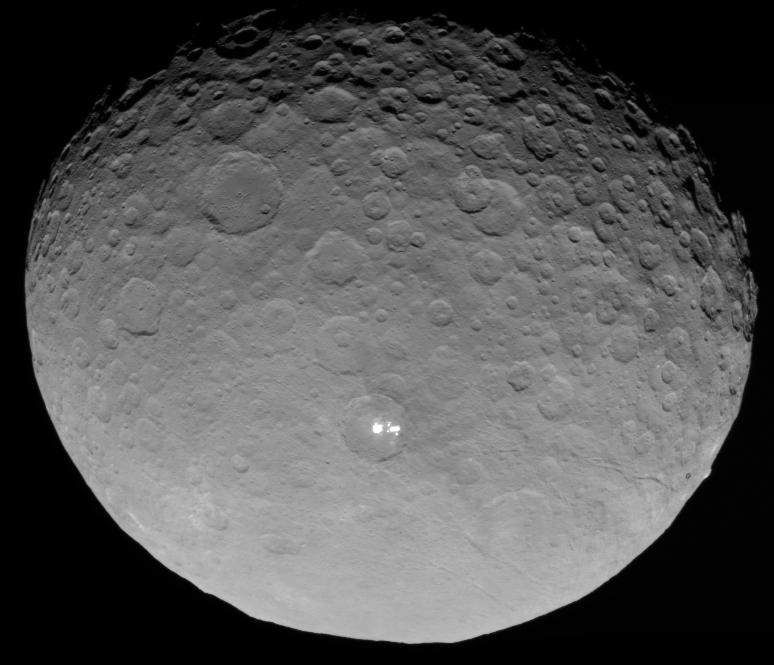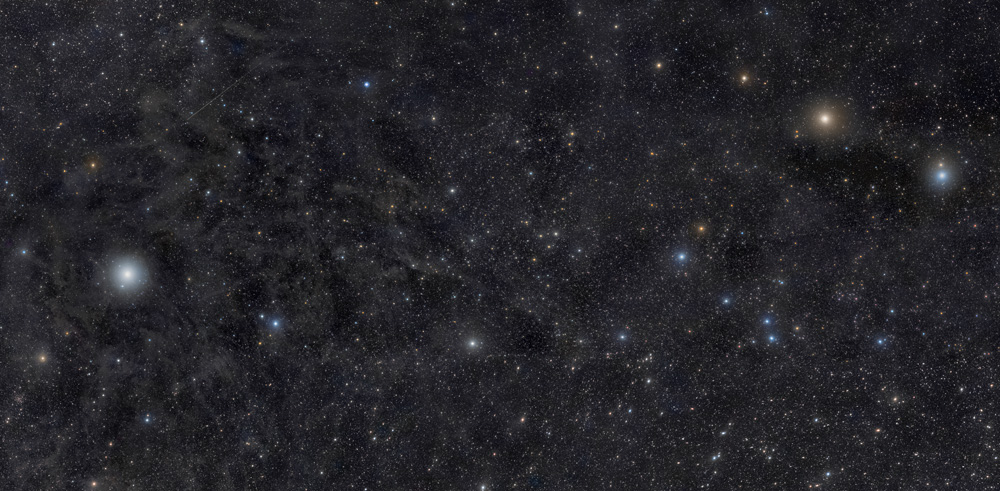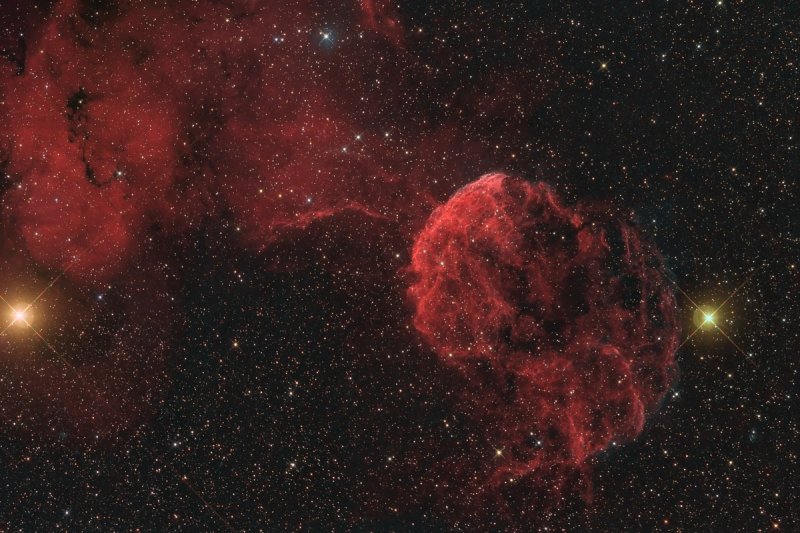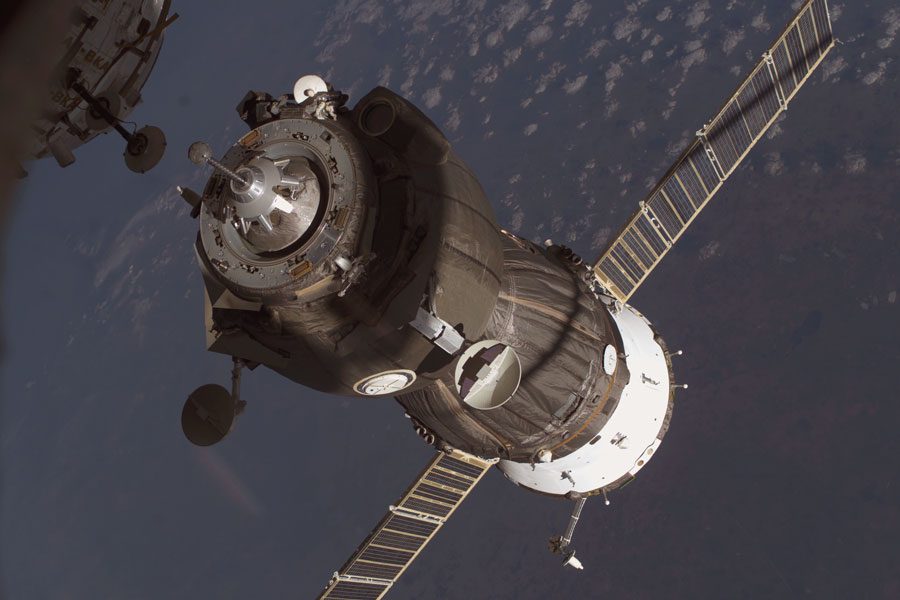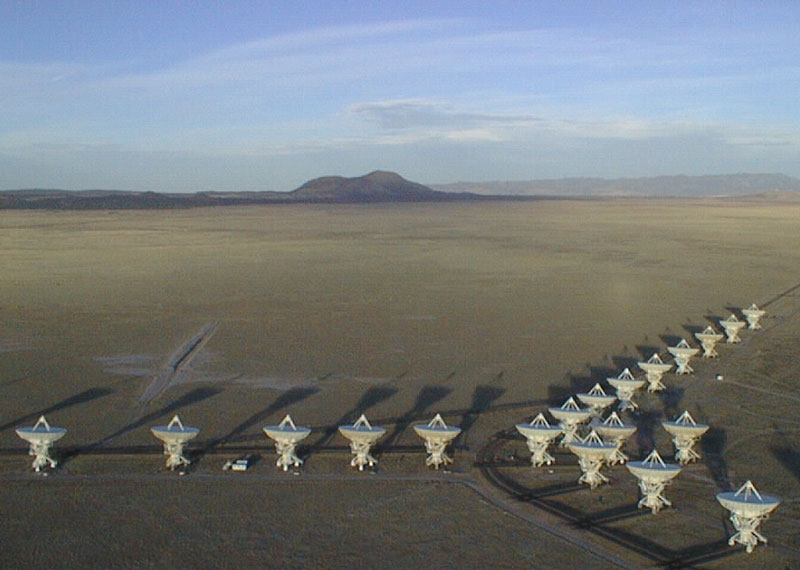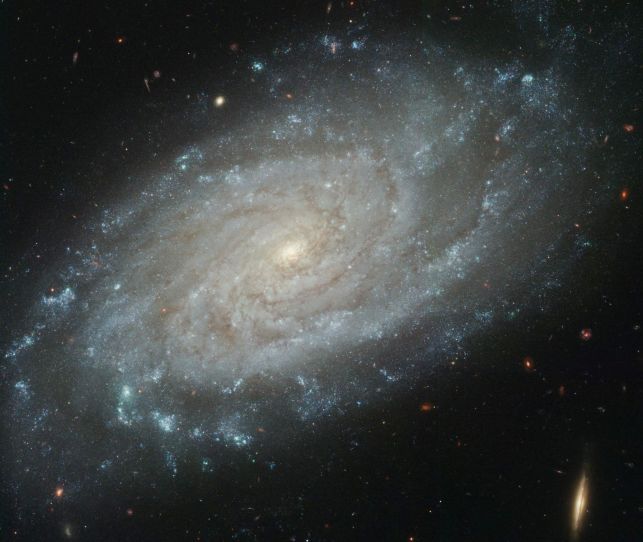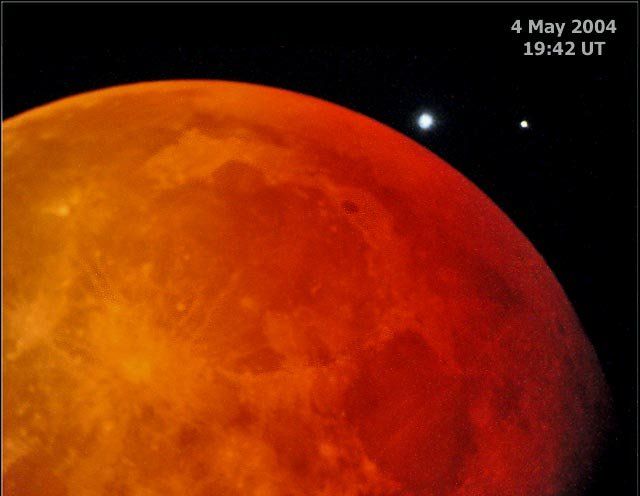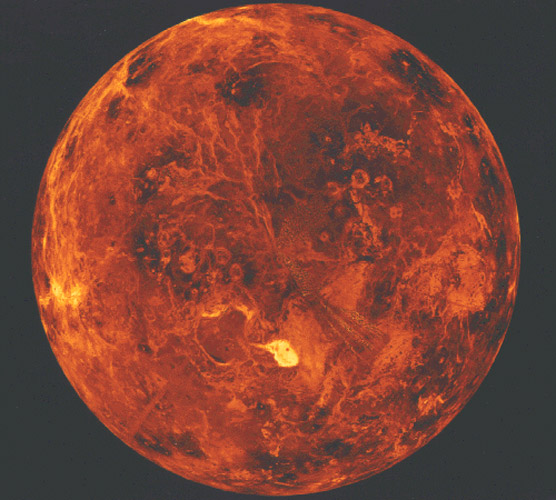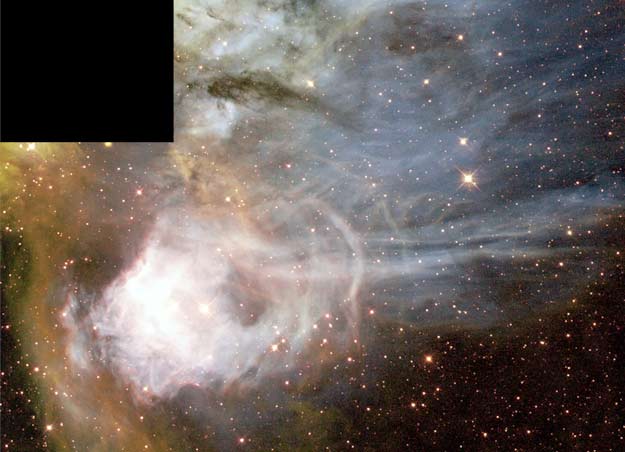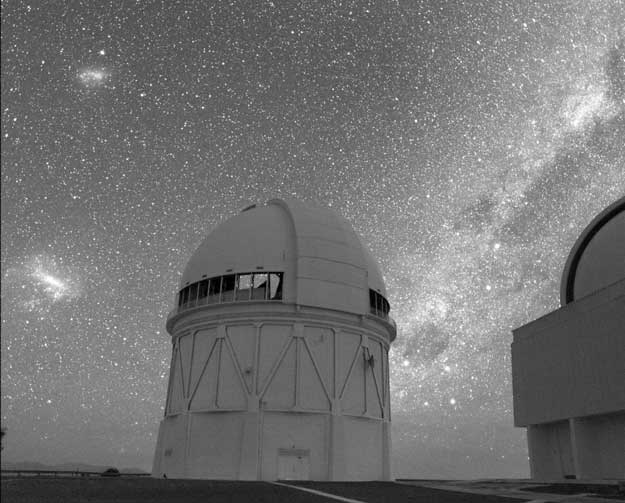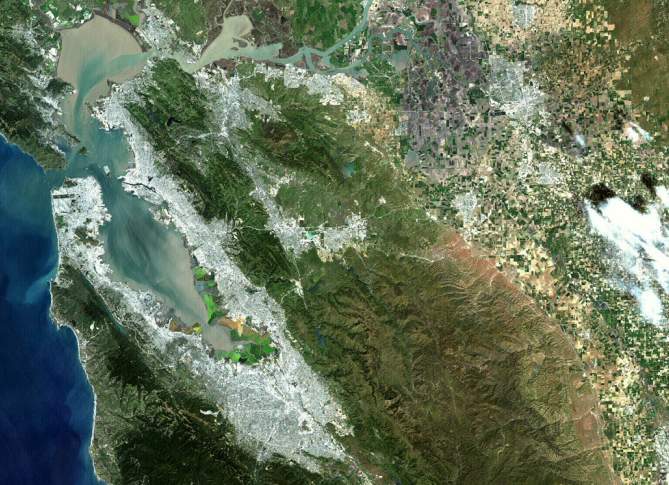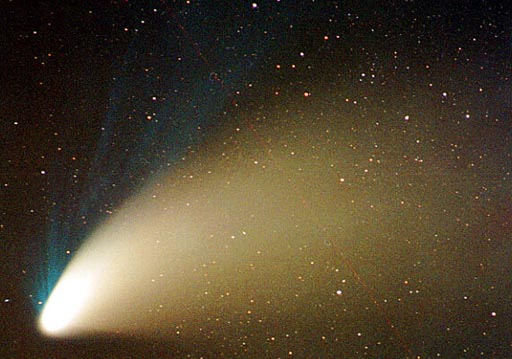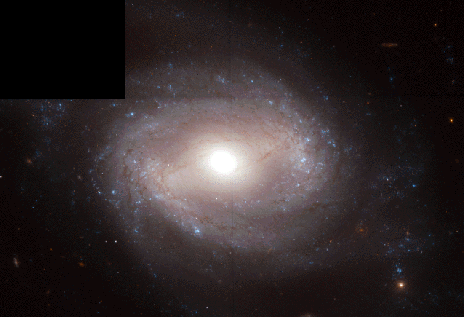| << Previous | Index | Next >> |
2015 Now at Ceres, Dawn's camera recorded this closer view of the dwarf planet's northern hemisphere and one of its mysterious bright spots on May 4. A sunlit portrait of a small, dark world about 950 kilometers in diameter, the image is part of a planned sequence taken from the solar-powered spacecraft's 15-day long RC3 mapping orbit at a distance of 13,600 kilometers (8,400 miles). The animated sequence shows Ceres' rotation, its north pole at the top of the frame. Imaged by Hubble in 2004 and then by Dawn as it approached Ceres in 2015, the bright spot itself is revealed to be made up of smaller spots of reflective material that could be exposed ice glinting in the sunlight. On Saturday, Dawn's ion propulsion system was turned on to spiral the spacecraft into a closer 4,350-kilometer orbit by June 6. Of course another unexplored dwarf planet, Pluto, is expecting the arrival of a visitor from Earth, the New Horizons spacecraft, by mid-July.
2014
Credit: NASA, UStream, HDEV Project
2013
Click to play embedded YouTube video.
Images Credit: NASA, ESA; Visualization: Frank Summers (STScI); Simulation: Chris Mihos (CWRU) & Lars Hernquist (Harvard)
2012
Click to play embedded YouTube video.
Images Credit: NASA, JPL-Caltech, UCLA, MPS, DLR, IDA; Animation: German Aerospace Center (DRL)
2011 At 2nd magnitude, Polaris is far from the brightest star in the night sky. But it is the brightest star at the left of this well-composed, starry mosaic spanning about 23 degrees across the northern sky asterism dubbed the Little Dipper. Polaris is famous as the North Pole Star, a friend to navigators and astrophotographers alike, but it's not located exactly at the North Celestial Pole (NCP) either. It's presently offset from the NCP by 0.7 degrees. Sliding your cursor over the picture will locate Polaris and the NCP as well as other stars of the Little Dipper. The stars are shown with their proper names preceded by their greek alphabet designations within the ancient constellation Ursa Minor, the Little Bear. Dust clouds suspended above the plane of our Milky Way Galaxy are also faintly visible throughout the wide field of view.
2010
[imghover6=http://apod.nasa.gov/apod/image/1005/Ig ... hi_900.jpg]http://apod.nasa.gov/apod/image/1005/Ig ... hi_900.jpg[/imghover6]Image Credit & Copyright: Babak Tafreshi (TWAN)
2009 Normally faint and elusive, the Jellyfish Nebula is caught in this alluring wide-field telescopic view. Flanked by two yellow-tinted stars, Mu and Eta Geminorum, at the foot of a celestial twin, the Jellyfish Nebula is the brighter arcing ridge of emission with dangling tentacles right of center. In fact, the cosmic jellyfish is seen to be part of bubble-shaped supernova remnant IC 443, the expanding debris cloud from a massive star that exploded. Light from the explosion first reached planet Earth over 30,000 years ago. Like its cousin in astrophysical waters the Crab Nebula supernova remnant, IC 443 is known to harbor a neutron star, the remnant of the collapsed stellar core. Emission nebula Sharpless 249 fills the field at the upper left. The Jellyfish Nebula is about 5,000 light-years away. At that distance, this image would be almost 200 light-years across.
2008 Looking out a window of the International Space Station brings breathtaking views. Visible vistas include a vast and colorful Earth, a deep dark sky, and an occasional spaceship sent to visit the station. Visible early last month was a Soyuz TMA-12 spacecraft carrying not only supplies but also three newcomers. The three new astronauts were Expedition 17 commander Sergei Volkov, flight engineer Oleg Kononenko, and spaceflight participant So-yeon Yi. Yi returned to Earth a few days later, while Volkov and Konenenko are scheduled to return in a few months. The docking module pictured above involved the Pirs Docking Compartment. The Expedition 17 crew, including NASA flight engineer Gregory Chamitoff, will carry out repairs on the ISS, explore new methods of living in space, and conduct research in space including the effects of space radiation on vitamin molecules.
2007
Click to play embedded YouTube video.
Credit: NASA, JPL, Doug Ellison
2006 The most photogenic array of radio telescopes in the world has also been one of the most productive. Each of the 27 radio telescopes in the Very Large Array (VLA) is the size of a house and can be moved on train tracks. The above pictured VLA, inaugurated in 1980 is situated in New Mexico, USA. The VLA has been used to discover water on planet Mercury, radio-bright coronae around ordinary stars, micro-quasars in our Galaxy, gravitationally-induced Einstein rings around distant galaxies, and radio counterparts to cosmologically distant gamma-ray bursts. The vast size of the VLA has allowed astronomers to study the details of super-fast cosmic jets, and even map the center of our Galaxy. An upgrade of the VLA is being planned.
2005 Similar in size and grand design to our own Milky Way, spiral galaxy NGC 3370 lies about 100 million light-years away toward the constellation Leo. Recorded here in exquisite detail by the Hubble Space Telescope's Advanced Camera for Surveys, the big, beautiful face-on spiral does steal the show, but the sharp image also reveals an impressive array of background galaxies in the field, strewn across the more distant Universe. Looking within NGC 3370, the image data has proved sharp enough to study individual pulsating stars known as Cepheids which can be used to accurately determine this galaxy's distance. NGC 3370 was chosen for this study because in 1994 the spiral galaxy was also home to a well studied stellar explosion -- a type Ia supernova. Combining the known distance to this standard candle supernova, based on the Cepheid measurements, with observations of supernovae at even greater distances, can reveal the size and expansion rate of the Universe itself.
2004 Moderately bright Zubenelgenubi is the star just off the upper right hand limb of an eclipsed Moon in this telescopic view from Port Elizabeth, South Africa. Actually the second brightest star in the constellation Libra, Zubenelgenubi is fun to pronounce (try zoo-BEN-al-je-NEW-bee ...) and rewarding to spot in the night sky as it has a fainter companion star, seen here on the far right. Astronomer Francois du Toit reports that both stars were visible to the unaided eye on the night of May 4th, during the Moon's total eclipse phase. Orbiting a common center of gravity once every 200,000 years or so, the two stars are both larger and hotter than the Sun. About 77 light years away they are separated from each other by over 730 light hours -- about 140 times Pluto's average distance from the Sun. Zubenelgenubi was once considered the southern claw of the nearby arachnologically correct constellation Scorpius. What star was the northern claw? Zubeneschamali, of course.
2003 If you could look down on the North Pole of Venus what would you see? The Magellan probe that orbited Venus from 1990 to 1994 was able to peer through the thick Venusian clouds and build up the above image by emitting and re-detecting cloud-penetrating radar. Visible as the bright patch below central North is Venus' highest mountain Maxwell Montes. Other notable features include numerous mountains, coronas, impact craters, tessera, ridges, and lava flows. Although the size and mass of Venus are similar to the Earth, its thick carbon-dioxide atmosphere has trapped heat so efficiently that surface temperature usually exceeds 700 kelvins, hot enough to melt lead.
2002 Why is N44C glowing so strangely? The star that appears to power the nebula, although young and bright, does not seem hot enough to create some of the colors observed. A search for a hidden hotter star in X-rays has come up empty. One hypothesis is that the known central star has a neutron star companion in a very wide orbit. Hot X-rays might only then be emitted during brief periods when the neutron star nears the known star and crashes through a disk of surrounding gas. Future observations might tell. N44C, pictured in the above Hubble Space Telescope image, is an emission nebula in the Large Magellanic Cloud, a neighboring galaxy to our Milky Way Galaxy. Flowing filaments of colorful gas and dark dust far from the brightest region are likely part of the greater N44 complex. It would take light about 125 years to cross N44C.
2001 High atop a Chilean mountain lies one of the premier observatories of the southern sky: Cerro Tololo. Pictured above is one of the premier telescopes of the Cerro Tololo Inter-American Observatory (CTIO) and of the past quarter-century: the 4-meter Blanco Telescope. Far behind the telescope are thousands of individual stars and diffuse light from three galaxies: the Small Magellanic Cloud (upper left), the Large Magellanic Cloud (lower left), and our Milky Way Galaxy (right). Visible just to Blanco's right is the famous superposition of four bright stars known as the Southern Cross. The observatory structures are lit solely by starlight.
2000 Scroll right to unfold one of the great panoramas ever taken on the surface of Mars. For best viewing, click and hold the right arrow icon at the bottom of your browser window. This image, dubbed a "presidential panorama" by the Mars Pathfinder team, shows in colorful detail the surroundings of the Sagan Memorial Station. Now look closely at the big rock midway through the scrolling picture. That rock is called Yogi and just to its left is the robot Sojourner Rover taking measurements of it. Other now-famous rocks are also visible including Barnacle Bill and Flat Top. After this picture was taken Sojourner went on to analyze a rock named Scooby Doo. The Mars Pathfinder mission landed on 1997 July 4 and collected data for about three months. Analysis indicates that the Pathfinder site was likely awash in water in the distant past, but has been dry for the last two billion years.
1999 Launched last month, NASA's Landsat 7 spacecraft now orbits planet Earth. Looking down from an altitude of 700 km, Landsat 7 can map the planet's surface in visible and infrared bands and resolve features 30 meters across or smaller. For example, this striking engineering test image is a natural-looking color composite of 3 different visible wavelength bands. It nicely shows details of urban areas around San Francisco, California, USA, nestled in the surrounding terrain (north is up). Flowing blue-green colors track the spring runoff from the Sierras to the west and neighboring mountains into the bay and out into the Pacific ocean. Landsat 7 is currently performing well in its check out phase and controllers are preparing the satellite for regular operations.
1998 Comets move against a field of background stars. Their apparent motion is slow but carefull tracking reveals their orbits, allowing these visitors to the inner solar system to be identified as old or new acquaintances. Recently a new comet, designated 1998 H1, was discovered by observer Patrick L. Stonehouse of Wolverine, Michigan, USA, and announced on April 26. At 10th magnitude, comet Stonehouse is too faint to be seen by the unaided eye, but it is presently a popular object for telescope-equipped comet watchers. This false color picture of comet Stonehouse was taken on May 1st at Limber Observatory and is a composite of 8 exposures each 60 seconds long. The sequence of exposures was made with the telescope following the background stars. The individual pictures were then aligned on the comet and added together. Because of the comet's relative motion, the combined multiple-exposure shows trails of progressively offset star images but nicely captures the comet's coma and faint, tenuous tail.
1997 What's happening to Comet Hale-Bopp's blue ion tail? The comet's ion tail is fluctuating more rapidly as it passes a region of changing solar wind. As the comet passes from north to south, it crosses the plane of the Sun's equator, where the solar magnetic field changes direction. Ions from the solar wind, which cause Comet Hale-Bopp's ion tail, act unpredictably here. Therefore, Comet Hale-Bopp's ion tale may show unusual structure or even a disconnection - where the tail appears to break off and then reestablish itself later. The above picture, taken April 30th, indeed shows unusual structure in the blue ion tail.
1996 In this century, the discovery that the Universe is expanding has produced a revolution in human thought about the Cosmos. American astronomer Edwin Hubble played a major role in this profound discovery, coining the "Hubble constant". This single number describes the rate of the cosmic expansion, relating the apparent recession velocities of external galaxies to their distance. Two groups of astronomers trying to measure this fundamental constant using the Hubble Space Telescope (HST) are continuing to report conflicting results. One group, led by astronomer Allan Sandage, measures distances to galaxies using pulsating Cepheid variable stars and supernovae observed in galaxies like the Virgo Cluster spiral galaxy, NGC4639, shown above. This galaxy is the most distant one to which Cepheid-based determinations have been made and was also the site of a well-studied 1990 supernova. Their results favor a relatively small Hubble constant (slow expansion rate) of about 55 kilometers per second per megaparsec which means that galaxies one megaparsec (3 million lightyears) distant appear to recede from us at a speed of 55 kilometers per second. A substantially faster expansion rate (larger Hubble constant) is being reported by astronomer Wendy Freedman and collaborators, also based on HST data. The value of Hubble's constant was recently the subject of a popular public debate titled "The Scale of the Universe 1996: The Value of Hubble's Constant".
| << Previous | Index | Next >> |
